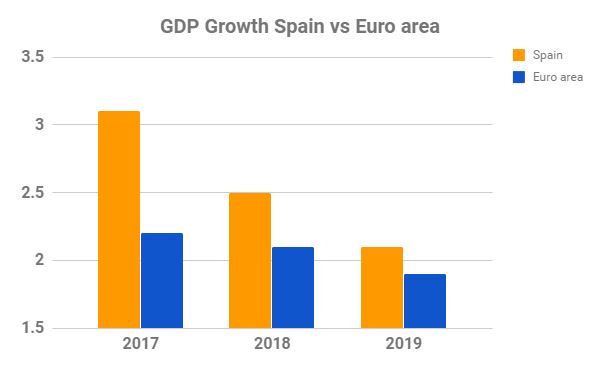 Reading time 2 minutes. Use our table of content for a quick read.
Reading time 2 minutes. Use our table of content for a quick read.
Last Updated on 12/03/2023 by STEPHANE
Automatic translation from Google translate:
Spain GDP growth confirmed above EU for 2019 and 2020 by the European Commission
The European commission has just released it’s last report with economic expectations for all the European countries. Here are the main details for Spain:
Before investing anywhere, it’s always good to check the Economy and the macroeconomic data of the country. There is a good news: the economic expectations of Spain are revised upwards.
Here is the summary of the analysis of the European Commission:
The expected mild deceleration of real GDP growth materialized in the first three quarters of 2018. In the last quarter, real GDP growth regained some momentum and expanded by a robust 0.7%, partly due to a rebound in net exports. As a result, real GDP in 2018 grew by 2.5%.
In fact, the Spanish GDP growth expectations remain above EU average: 2.1% in 2019 & 1.9% in 2020
The European commission sees the Spanish growth decelerating further to 2.1% in 2019 and 1.9% in 2020 as the cycle matures. The deceleration is mainly driven by a slowdown in private consumption, which is expected to grow more slowly than disposable income, as pent-up demand is absorbed and households increase their saving rate.
Slower GDP growth
- Domestic demand remains the main engine of growth
- Job creation is forecast to ease, also due to the expected dampening impact of the increase in the minimum wage. Still, employment growth is set to allow for
further reductions in the unemployment rate. - Investment in both equipment and construction is also expected to decelerate in line with final demand, after buoyant growth in recent years.
- Exports add a negative impact on GDP growth.
- Further easing going into 2020 but better growth than the rest of Europe
Compare the GDP growth expectations for Spain vs other EU countries with our interactive charts:
You will see right away that Spain is in the winning group in Europe.
2019 GDP Growth expectations – interactive chart
2020 GDP Growth expectations – interactive chart
Source: European Commission
Expectations
- Growth is expected to continue easing over the forecast horizon, to 2.1% in 2019 and 1.9% in 2020 but remains higher than EU averages.
- Private consumption is projected to remain the main driver of growth, but to slow down as the pace of job creation moderates.
- Residential construction and equipment investment are set to ease gradually.
Net exports contributing negatively (vs positively before) to growth
- The contribution of the external sector to growth is projected to remain negative but improve in 2019, and turn
neutral in 2020.
Despite weak growth in global trade, exports are forecast to accelerate slightly in 2019 and
2020, as Spain’s export market shares gradually improve after a sharp deterioration in 2018. At the same time,
imports are expected to decelerate broadly in line with final demand.
The unemployment rate to fall to about 14% by 2019
- The unemployment rate to fall to about 14% by 2019, a reduction from 21% at its peak in 2013.
- Wage growth is expected to accelerate in 2019, partly under the impact of the increase in the minimum wage, and to moderate but still be above inflation in 2020.
Inflation expected to moderate again
Headline inflation reached 1.7% in 2018 and is forecast to decline to 1.2% in 2019 due to base effects from oil price developments. It is then set to increase to 1.5% in 2020, as core inflation gradually picks up. Wage growth is expected to accelerate in 2019, partly under the impact of the increase in the minimum wage, and to moderate but still be above inflation in 2020.
Risks to the outlook
- Risks to the forecast relate mainly to a weaker than expected global environment and increased uncertainty, both
domestic and external.
Strong growth continues to reduce the deficit
- After narrowing to 4.5% of GDP in 2016, Spain’s general government deficit continued to decrease in the first half of 2017.
- The government deficit of 3.1% of GDP is expected for 2017.
- The fiscal deficit for 2018 was driven by the relatively strong macroeconomic performance which led to a narrowing of the deficit to 2.5% of GDP in 2018.
- In 2019, at unchanged policies, it is expected to narrow further to 1.7% of GDP.
The general government debt ratio is expected to decrease slightly to 95.5% of GDP in 2019, as a result of relatively strong nominal GDP growth and the narrowing budget deficit.
Read more?
Check the previsions from the bank of Spain in our other article: Spanish GDP growth strong to 2021
Looking for an expert in Spain? Ask us directly!






